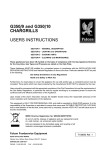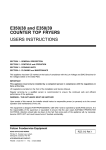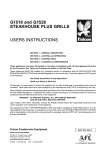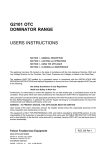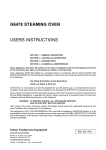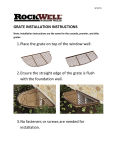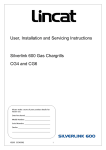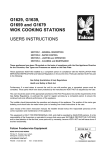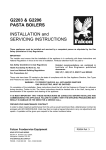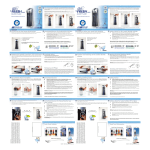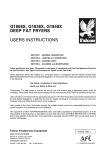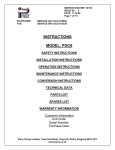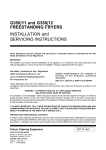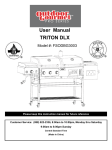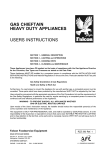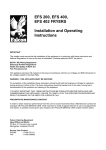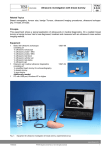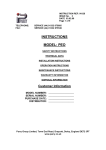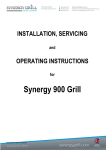Download G350-10!User Manual
Transcript
G350/9 and G350/10 CHARGRILLS USERS INSTRUCTIONS SECTION 1 - GENERAL DESCRIPTION SECTION 2 - LIGHTING and OPERATIONS SECTION 3 - COOKING HINTS SECTION 4 - CLEANING and MAINTENANCE These appliances have been CE-marked on the basis of compliance with the Gas Appliance Directive for the Countries, Gas Types and Pressures as stated on the Data Plate. These Appliances MUST BE installed by a competent person in compliance with the INSTALLATION AND SERVICING INSTRUCTIONS and National Regulations in force at the time. Particular attention MUST be paid to the following: Gas Safety (Installation & Use) Regulations Health and Safety at Work Act Furthermore, if a need arises to convert the appliance for use with another gas, a competent person must be consulted. Those parts which have been protected by the manufacturer MUST NOT be adjusted by the User. Users should be conversant with the appropriate provisions of the Fire Precautions Act and the requirements of the Gas Safety Regulations. in particular the need for regular servicing by a competent person to ensure the continued safe and efficient performance of the Appliance. Upon receipt of the User's Instruction manual, the installer should instruct the responsible person(s) of the correct operation and maintenance of the Appliance. This equipment is ONLY FOR PROFESSIONAL USE, and shall be operated by QUALIFIED persons. It is the responsibility of the Supervisor or equivalent to ensure that users wear SUITABLE PROTECTIVE CLOTHING and to draw attention to the fact that, some parts will, by necessity, become VERY HOT and will cause burns if touched accidentally. Falcon Foodservice Equipment HEAD OFFICE AND WORKS PO Box 37, Foundry Loan, Larbert. Stirlingshire. Scotland. FK5 4PL AFE SERVICELINE CONTACT PHONE - 01438 363 000 FAX - 01438 369 900 RZZ 102 Ref. 2 SECTION 2 - LIGHTING and OPERATIONS The G350/9 and G350/10 simulated charcoal grills SETTING THE LAVA ROCK SECTION 1 - GENERAL DESCRIPTION are part of the Falcon 350 series of equipment. All individual units comprising the series are of modular dimensions, enabling suites of units to be installed in a matching line whether counter-mounted, as are these appliances, or floor-mounted i.e. ranges and fryers. The two models are similar in design, G350/9 unit is 350mm wide and G350/10 is 700mm wide. G350/10 model has two burners, each individually controlled by a safety tap: ignition being manual by means of a taper. The G350/9 unit has a single burner. The heat inputs are 19.2kW (70,000 Btu/hr) and 9.6kW (32,750 Btu/hr) respectively. The cooking surface consists of a number of cast iron brander bars. (Three on G350/9 and Six on G350/10), which can be used in any of four positions by adjusting tilt handles and turning bars over. During cooking process, excess fat is drained down grooves in the bars into a removable fat drawer at bottom of unit. Behind fat drawer is a removable drip tray which collects lava rock remnants, food particles etc. Lava rock, sufficient for one filling, is supplied with each appliance. It is important only to use lava rock as supplied by Falcon. DO NOT attempt to use ordinary charcoal etc. Brander bars are lifted out to expose grates which will carry the lava rock. Do not tip contents of bag of rock on to grates. Place a single layer of lava rock over grates. Spread evenly leaving spaces (as shown in Figure 3) between pieces and covering entire grate area. Discard any small chips of rock, as they may lodge between grates and block heat flow. Excessive rock will result in much of the gas burned being used to overheat grates causing them to distort, or burn out prematurely. Important Note Do not tip contents of the bag of rock directly onto grates. The dust, which accumulates naturally at bag bottom during shipment, must be discarded as it will clog burner ports and affect performance. THE FOLLOWING EXAMPLE SHOWS ROCK DISTRIBUTION ON G350/10 (700mm WIDE) Figure 1 - G350/9 Chargrill Figure 2 - G350/10 Chargrill BRANDER BARS Brander bars, fitted in a set of three/six, have integral drain channels (see Figure 4) which run fat released during cooking into a collecting trough at front and hence down to removable fat drawer. Figure 4 The bars can be inverted i.e. they can be used with rear flange facing down or up. Additionally, front ends of bars can be positioned at two alternative heights by manipulating tilt handles (see Figure 5). This produces a total of four cooking positions, as detailed below. Cooking Position 1 2 3 4 Notes Figure 5 Rear Front Flange Tilt Up Up Down Down Up Down Up Down LIGHTING INSTRUCTIONS Each tap controls an individual burner. To operate, push knob in and turn it anti-clockwise to achieve desired flame requirements. Lighting The Burners Warning NEVER ATTEMPT TO LIGHT THE BURNERS THROUGH THE SIMULATED CHARCOAL. If pilot is extinguished intentionally or otherwise, no attempt to re-light gas should be made until at least 3 minutes have elapsed. Brander Angle Horizontal Minimum Slope Moderate Slope Maximum Slope 1. Position 4 is used when cooking foods which release a lot of fat, thus causing excessive flaring, if fat is not drained away quickly. 2. A limited amount of flaring and smoking is desirable as this gives meat a better appearance and flavour. 3. Dual cooking positions (G350/10 only) can be used if three brander bars on one side are positioned with rear flanges upward and the other three bars have rear flanges down i.e. one side giving Positions 1 or 2 while other side provide Positions 3 or 4, depending upon position of tilt handles. 1. Pull out fat drawer and apply a lighted taper up through centre opening and light either left or right pilot dependent upon which burner is required, then turn on appropriate gas tap to ignition position and push in. Hold knob in for a further 20 seconds and release. Check through viewing window that burner is lit. 2. Repeat for other burner, using other lighting port. To Light The Main Burner Turn control to high/low flame position. OFF Position IGNITION Position FULL ON Position LOW FLAME Position Figure 6 To Turn The Burner OFF For Short Periods Turn gas tap to ignition position as shown in Figure 6, hence leaving pilot lit. For Longer Periods (i.e. OVERNIGHT) Turn gas tap to off position, hence closing gas supply to both main and pilot burners. To Order Lava Rock Contact Falcon or your nearest distributor/ agent. Quote Spares No. 539113000 for ONE bag (1.75kg) of lava rock. G350/9 requires 1 bag of lava rock. G350/10 requires 2 bags of lava rock. SECTION 3 - COOKING HINTS After lighting burners, allow unit to heat up for at least 30 minutes with burners full on to achieve correct working temperature of lava rock and grid bars. This is recognised when rock shows a red glow at bottom, rock need not be red throughout and will be giving off infra-red heat as required for fast cooking. The gas can then be turned down but not more than necessary to maintain the red glow in rock. The temperature varies across depth of cooking grid: The hottest area being at rear becoming progressively cooler toward the front, enabling rare and well done cooking to be achieved on steaks etc. For good cooking, correct temperature and time are very important. Thick cuts of meat etc, require a longer cooking time at a lower temperature than thinner cuts to avoid burning and should be cooked nearer the front of the grids. Steaks or chops should be branded on both sides to retain their juices then cooked as required with as few turns as possible. Rare cooking should be done at rear of cooking area where food items will cook more quickly on the outside. Attractive branding is produced on food by the searing action of the hot grid bar edges. A criss-cross pattern can be attained by turning food through 90o halfway through cooking process. Fats dripping from meat will flare up on rock below and flavour cooking. A certain amount of flaring should occur to give this desirable flavouring but should not be allowed to become excessive when cooking fattier meats. When excessive flaring occurs, lower tilting handles to run off excess fat and when flaring subsides, return brander bars to original position. Cooking times vary considerably according to type of food, thickness and customer requirements i.e. RARE or WELL DONE, but experience will soon produce satisfactory results. For example: 100g high meat content beefburgers can be cooked in 6 minutes (3 minutes per side) and 20mm thick, good quality steaks take from 5 minutes (RARE) to 12 minutes (WELL DONE). These times are not meant to be rigidly adhered to, they are for general guidance only. SECTION 4 - CLEANING and MAINTENANCE Allow unit to cool before cleaning or removing parts. The stainless steel external body should be cleaned with soapy water as often as possible, rinse and dry. Brander bars should be removed for cleaning with a wire brush daily to prevent carbonising and to keep drain channels clear. Burners should be cleaned at least once a week to maintain maximum performance. To do this, it is necessary to first remove lava rock and burner grates. The hearth surround should be removed by lifting it upward. Burners are removed by lifting them out rearward to avoid damaging injectors and are best cleaned with a wire brush to remove deposits of lava dust and grease which may block burner ports. If allowed to accumulate, this will effect efficiency of the appliance. With hearth surround removed, the fat trough can be lifted out and thoroughly washed, rinsed and dried. Replacement of parts should be done in reverse order. Ensure burners are dry and free from any cleaning material before replacing. Regular usage of appliance will dictate replacement of the lava rock - approximately every six months. Note Should burner injectors become blocked, cleaning should be carried out by an approved service engineer. The fat drawer should be removed, emptied and thoroughly washed, rinsed and dried daily. Periodic checks must be made during use to avoid overflowing. Fat drawer should be removed by sliding it forwards. Care should be taken in replacing fat drawer to ensure it is pushed fully backwards into correct position. The drip tray behind fat drawer should be removed regularly for cleaning. The tray is removed by sliding it forward. Care must be taken when replacing it to ensure the handles (large spacer brackets) are at front of unit and that the tray is pushed fully backward into correct position.




